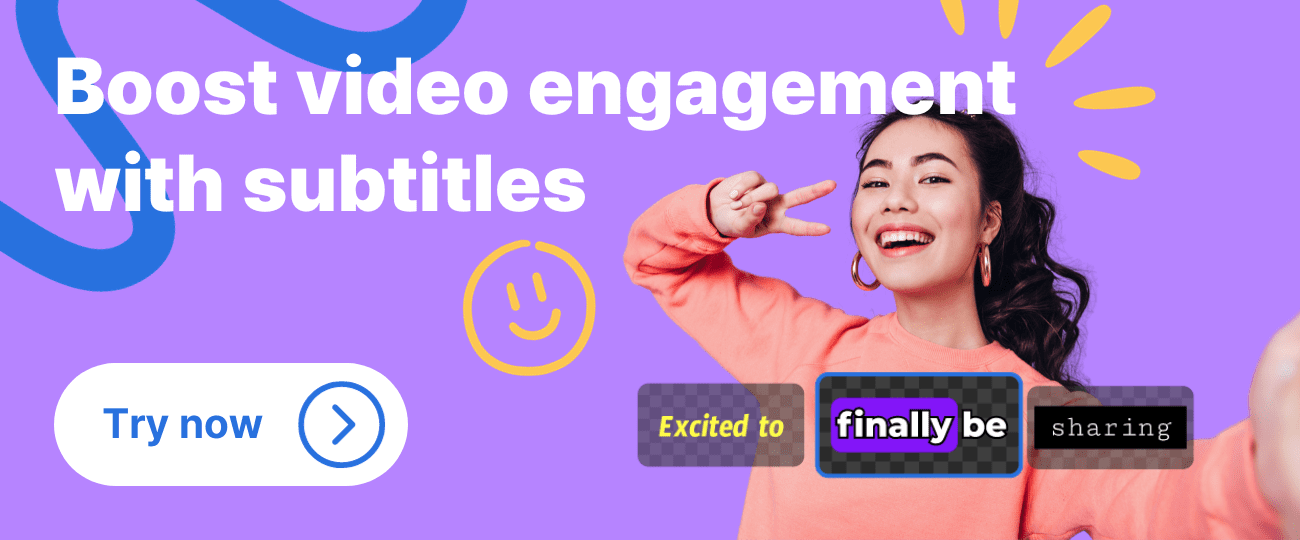
Incorporating subtitles for language learning is a great way to boost your or your student’s chances of success. It is easy and can help accelerate language learning in many different areas. This article will look at exactly how subtitles help language learners and the best ways to add them to your videos.
How Subtitles Facilitate Language Learning
Watching videos with subtitles can improve language skills in several different ways. The first benefit to language learners is the dual audio and visual input. This multisensory input helps to reinforce language acquisition by simultaneously hearing the pronunciation and combining it with the spelling of the words.
Some people are visual learners, whereas others learn more quickly from audio input. Having the option of both means everyone can benefit, regardless of their preferred learning style. You may find that everyone learns slightly better by combining the two as more context is provided.
Improve Listening and Reading Comprehension
Lots of independent language learners have a well-defined learning process. When acquiring language, the two types of input are reading and listening. There may be people who favor one over the other, but both are important if you want to gain a complete understanding of a foreign language.
Reading books is clearly a valuable way to improve your reading skills. However, sometimes books can use language that isn’t commonly used in daily life so you may find more authentic language within videos. Videos are also created more quickly and can provide content related to current events.
Creating subtitles is easy, and as we explore the benefits of subtitling, you will see it is a no-brainer to help language learners.
Expand Vocabulary and Contextual Understanding
Watching foreign movies with subtitles helps to expose language learners to new conversational phrases and vocabulary within a real-life context that is hard to get from textbooks. This is particularly true for more advanced learners who already understand the structure of a language and its basic vocabulary.
If you are an English speaker trying to learn another language, there are a couple of things to consider when choosing your movie subtitles. The main question is whether you want to use English or foreign-language subtitles.
The answer to this will largely depend on familiarity. This means familiarity with the target language and also how familiar you are with the source material.
If you are a beginner language learner, you may need more than foreign language subtitles to improve your vocabulary. If you use English subtitles, you will better understand the source material while picking up some words and the general flow of conversations in your target language.
Once you have a basic understanding of grammar, vocabulary, and the movie you plan to watch, you can switch to subtitles in your target language. This basic level of comprehension sets you up to expand your vocabulary from watching movies with subtitles in the target language through “comprehensible input.”
Comprehensive input refers to language learners can understand, even if they do not fully comprehend all the words and structures. It is about working out the meaning of things in a natural context, just as a child would when learning their native language. Subtitles help to give additional context to this learning process and accelerate language acquisition.
Enhance Pronunciation and Speaking Skills
It may not be immediately clear how watching subtitled videos can improve your pronunciation and speaking skills, but it can actually help you in several different ways.
Watching movies, TV shows, or YouTube videos in foreign languages with subtitles exposes you to how people really speak. This can shock the system when you are coming from textbooks. In the real world, people talk quickly, with an accent, and use slang. Subtitles can help to bridge the gap from the theoretical to the practical.
If you’re watching a movie where the character uses an accent you haven’t heard before, you can follow along with the subtitles showing text you are familiar with. This helps you understand how real people pronounce those words, and you can mimic this pronunciation.
To further familiarize yourself with speaking natively, you can reduce the playback speed, practice the pronunciation, and then replay it at a natural pace until you feel comfortable.
Types of Subtitles in Language Learning
There are several types of subtitle formats you can use to assist your language learning. The first choice is between using captions vs subtitles.
The basic difference between the two is that captions are a text version of what you are hearing, and subtitles are a translation into a language you are familiar with.
You can also implement dual subtitles, which means you have a caption of the original language being spoken and subtitles in your native language. These double subtitles give the best of both worlds. You gain context and understanding from your native subtitles while expanding your vocabulary and pronunciation from the captions.
Best Practices for Using Subtitles in Language Learning
As with subtitles used for any purpose, a few best practices must be followed for language learning.
A good subtitle example will use a sans-serif font so it is clearly legible. It will also use a background with a highly contrasting color to make it stand out more. Finally, it will be at a size appropriate for the screen it will be used on.
How To Implement Subtitles in Language Education Programs
When you are creating a language education program, subtitles are easy to implement. They can be auto-generated, or you can add them manually. You can also add multiple language options, depending on the mother tongue of the language learner.
AI tools can automatically translate into a range of languages making it easy to learn any language with subtitles, regardless of where you are or what language you already speak.
Join the Future of Subtitles for Language Learning Today
If you are ready to create a language learning program and want to implement subtitles to boost your students’ progress, sign up for your free trial of LOVO’s subtitle generator. LOVO offers a full suite of AI-powered content tools to create professional videos, whatever your goal.



